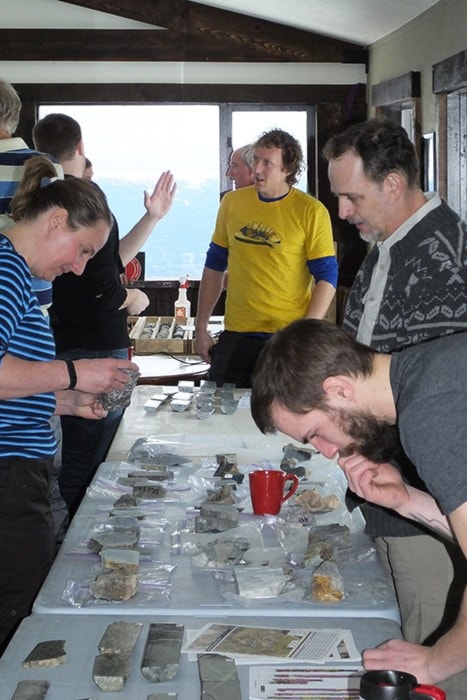Geologists and other mining stakeholders in ski pants were at Hudson Bay Mountain Friday to talk rocks.
Dubbed Ski Day and Core Shack, it was the last event of a three-day mining industry get-together in Smithers last week.
About 90 people from mining-related organizations from across B.C. attended the 26th annual Rock Talk put on by the volunteer Smithers Exploration Group (SEG).
Wednesday was an education day focusing on safety, followed by Thursday’s technical talks and a reception at the Smithers Curling Centre, and Friday’s mix of rocks and skis.
SEG president and UTM Exploration Services operations manager Rob Maurer said about half of the 90 attendees were from outside the region.
In 2014, there were 137 mining projects in B.C. that spent $338.4 million.
“Smithers definitely punches above its weight class,” said Maurer.
The province is divided into six mining regions, with the Northwest under the name Skeena. The northwest region accounted for 54 of those projects, with investment of $161 million.
“A wonderful thing about the exploration industry is you have to go out there and spend money looking around.
“So there are jobs created and economic opportunity going out and looking for something with complete understanding that you might get out there and find nothing.
“You might spend a couple million dollars and find something, it’s just not enough to really keep looking for it now.
“How many industries operate successfully by going out, spending a ton of money, hiring a bunch of people, and then leaving and cleaning up their little mess and going away?
“There’s going to be hundreds of those happening for every time you get a mine. I think that’s great. I think a lot of people in the Northwest embrace that,” said Maurer.
Mining representatives also apparently embrace skiing, as evidenced by the number taking to the hill Friday.
That part of the event was sponsored by Bureau Veritas (BV) Minerals, formerly Acme Labs, which has had a Smithers branch since 2008.
“Each individual brings up their own rocks,” said BV Minerals lab supervisor Dan Graves.
“Any company that has rocks wants to show them off. That’s kind of their baby.”
Dolly Varden mapping consultant Chris Sebert was showing his “babies” off Friday during his first visit to Smithers. He had a collection of minerals from the Kitsault Valley that included what he called indicator rocks.
“This is what we find close to the mineralization, especially the veining. It’s called potassic alteration,” explained Sebert as he held a sample stained bright yellow.
“It’s an associated alteration with the mineralization. So when you go and you prospect and map, you look for this type of thing happening and you say ‘aha, I’m coming close to something’.”
Telkwa’s Hans Smit is one of those prospectors who embraces the search. He was on the mountain with a table of core samples he hauled in from a site about 30 kilometres southwest of Prince George.
Building on the work of long-time prospector Rupert Seel, Smit has been working on the project for about three years.
Smit insisted the potential for successful mining operations in the Prince George area was high, but the search for gold would be more difficult in some ways.
He explained that what had been tested in the past is not necessarily what is actually in the ground due to the lack of exposed rock in the area.
“It’s quite inexpensive [in other areas] because you just walk and smack apart rocks. In that whole Prince George area there is very low rock outcrop. What you have there is glacial till,” said Smit.
“It’s got the right big scale geology to have big scale deposits. The challenge is to find them.”
Smit said it would take time, pointing out that the recently approved KSM gold and copper mine north of Stewart has been worked on since the 1970s.
“That’s the fun of it: you get a little bit of evidence and you do some more work,” said Smit.
